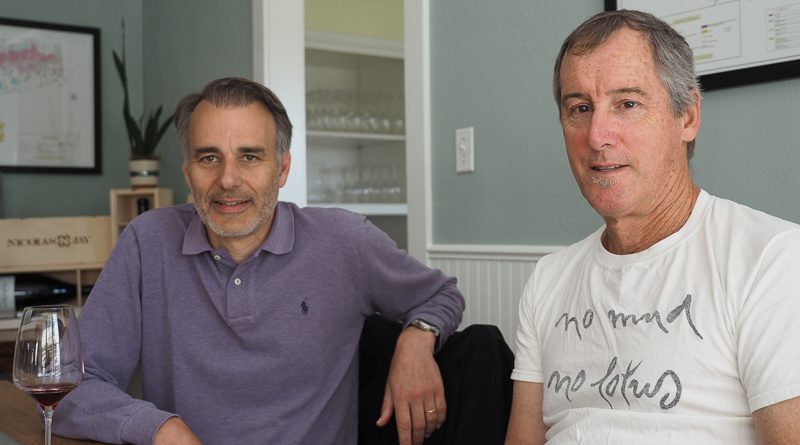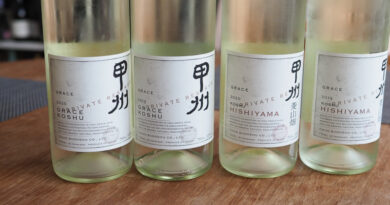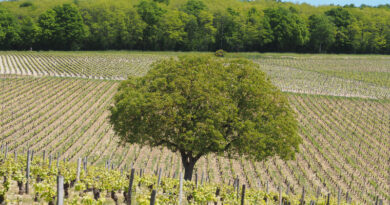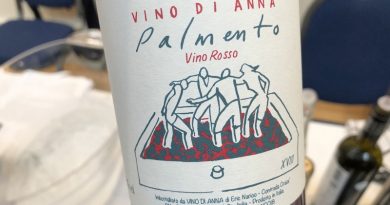Nicolas Jay, a new Oregon star
Jay Boberg and Jean-Nicolas Méo’s collaboration has already established itself among the Willamette Valley’s finest
Nicolas Jay is a collaborative project between two friends, one from the music industry, and the other a proprietor of a leading Burgundy domaine. Jay Boberg (pictured above, right) is the music guy: he co-founded IRS records and later spent a decade as president of MCA/Universal Records. The Burgundian is Jean-Nicolas Méo (left, above), who has been running family domaine Méo-Camuzet since the 1980s. They met at a dinner party in 1987 via Jay’s sister who studied with Jean-Nicolas in Pennsylvania, and have been friends since.
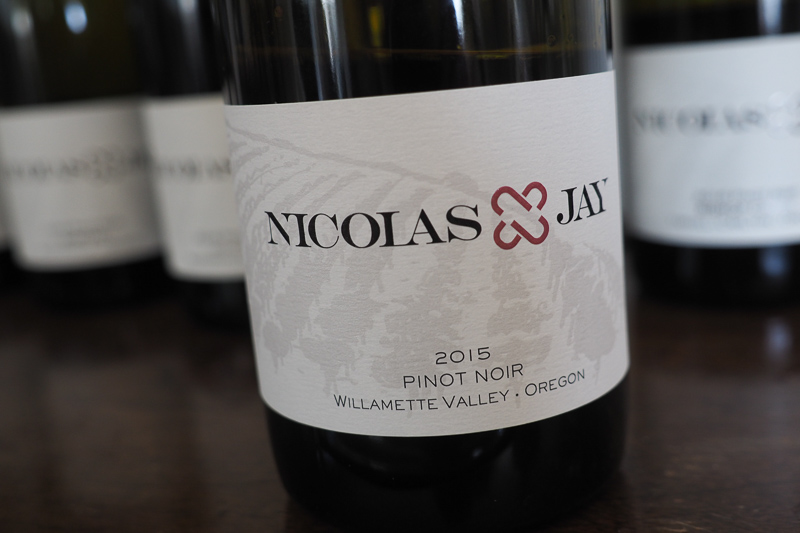
Jay started off as a classical musician. At university (UCLA), he became social secretary for the student union, booking all the bands, including celebrated acts Talking Heads and The Police. He made friends with Miles Copeland, brother of Police drummer Stewart, and together they decided to start a record label. Thus IRS was born in 1979. ‘I signed Oingo Boingo,’ says Jay, ‘we both signed The Go Gos and The Beat, I signed REM, and he signed Wall of Voodoo and The Cramps. We signed acts that we loved, and thank god there were enough people out there who liked them.’ He says the reason IRS worked is because he or Miles thought that every band they signed was the best thing that ever happened.
Then he caught the wine bug. His roommate at university worked summers for a wine distributor, and they travelled to Napa together, meeting Robert Mondavi. ‘While my friends were still drinking Jack Daniels and beer, I made the move to wine,’ says Jay. In his senior year he moved to Manhattan Beach, and their local Trader Joes used to have some smart wines discounted, which he and his roomies would drink together.
One of the key moments in Jay’s wine journey was meeting importer Kermit Lynch. ‘He was a big music guy, so he was interested in what I was doing.’ Jay began travelling for music, and tagging wine trips on the back the work ones, and Kermit helped set him up with appointments. And in the 1980s he bought a small vineyard in Napa with a buddy, right across from Montelena. They sold most of the fruit, but with some help from Montelena they made some wine. Jay says it was great fun, but already he was losing his love of Cabernet and gravitating towards Pinot Noir.
Jean-Nicolas Méo had a very different journey. His father inherited what is now the Méo-Camuzet domaine in 1959. It was then called Camuzet, and consisted of 11 hectares of vines, including 3 hectares in Clos Vougeot, some Richebourg, and half of the now-famous Cros Parantoux premier cru. These vines were farmed by four tenant farmers under the métayage (share-cropping) arrangement, and one of the four was the legendary Henri Jayer. In 1983 Jean-Nicolas’ father decided to start domaine bottling: because of some law changes, not to have made this move would have left him with hefty tax liabilities based on the asset value of the land, and so he asked Jean-Nicolas to take over running things. So, at age 20, in the middle of business studies in Paris, Jean-Nicolas decided to become a vigneron. He finished university, including some enology training, and by 1989 was permanently based in Burgundy. He was assisted by Jayer, and as the tenant farmers retired and a few new acquisitions were made, the domaine arrived at its current size of 16.5 hectares in 2008, with a négociant arm on the side.
The two friends wanted to do something together, and Oregon seemed like the perfect place. ‘What bought me here in the first place was personal connections,’ Jay says. ‘I wanted to do Pinot Noir, and I wanted to do something that wasn’t a folly. If you are starting a winery today in California today, you are probably someone who has a lot of money and you don’t care if you ever make any money.’ He adds, ‘maybe you are someone who likes building things, but at that stage in your life, where you are economically means that whether it is profitable or not is not your main criterion. I didn’t want to be that guy.’ At five vintages into his Oregon project, Jay thinks that they will be cashflow positive this year, or at least next. ‘I’m extremely proud of that.’ He says that there are parallels between Nicolas Jay and the way that IRS started. ‘I might be older and slightly more tired than I was when I was 20, but they are very similar. In the early days we weren’t paying the highest salaries, but we had cool bands and people knew that their fingerprints were going to be on the process: they got to create. We aren’t going to do well for a band if there are chains on the door. We can always help a band if we are in business. At IRS we never sacrificed quality, but at the same time we weren’t trying to get too far ahead on our skis. We have done the same thing at Nicolas Jay.’
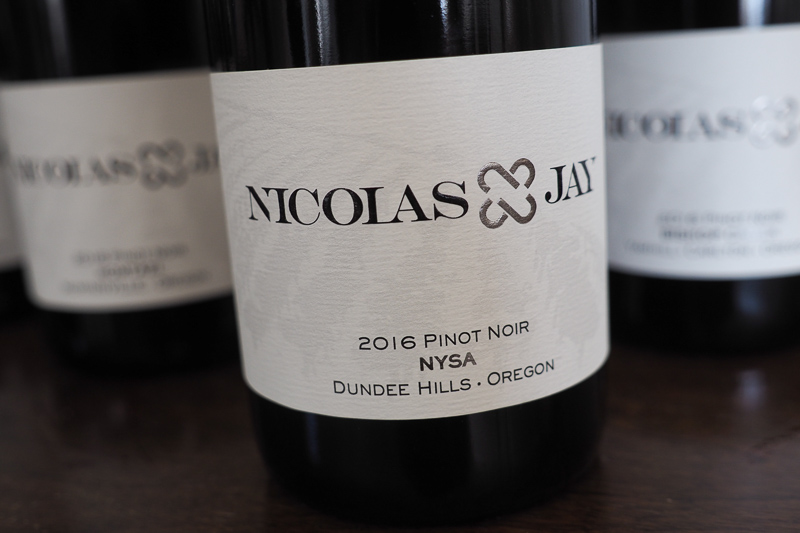
Initially the plan was to buy grapes and run a négociant operation. In Oregon, there’s a strong grower culture and most people buy grapes, even if they have estate vineyards. So they started a search lasting two years, in 2012 and 2013. Jean-Nicolas came out several times and they tried fruit and wine from about 200 different vineyards. ‘Jean-Nicolas is Jean-Nicolas, and everyone was very happy to see him,’ says Jay. ‘They all wanted to meet him. The great thing is that through those two years we were able to taste fruit from the same vineyard made by different protocols. Jean-Nicolas said I don’t want to do this unless we can make a world class wine: I have my Méo-Camuzet situation, and if it’s not world class, you don’t want to do this. Very early on, he said we can make amazing wine here.’
After a short while, though, they found a property that is now considered their estate vineyard, Bishop Creek in Yamhill Carlton. ‘We came across it in our due diligence in tasting fruit from lots of vineyards,’ says Jay. ‘We learned it was up for sale and bought it.’ It’s a 17 acre vineyard, mostly Pinot Noir, but with an acre of Chardonnay, and they have grafted over a further acre of Pinot Gris to Chardonnay.
The wines are currently being made at Sokol Blosser, but they began working at Adelsheim for the debut 2014 vintage. Jay describes David Adelsheim as ‘the pope’. He’s a fan of Méo-Camuzet and had visited Jean-Nicolas before. ‘What are your intentions here?’ asked David. They explained, and David offered to make the wine in his facility. But they did all the winemaking. After the 2016 vintage they left for Sokol Blosser, not for any reason other than practicality: all his tanks were among theirs, it was all intermingled, and they were going to start doing Chardonnay and would be competing for the press. Sokol Blosser offered them their own separate space.
The latest progression of the project is an exciting one. They have recently bought a property in the Dundee Hills with a barn and some plantable vineyard land. ‘We have enough validation in the market that we felt comfortable to do this,’ says Jay. ‘We have convinced ourselves this is not throwing good money after bad.’ It is a slightly cooler spot of 50 acres with Jory soils, and 25 acres will be planted. It has a barn which they will renovate, and this will become the winery. The previous owners were running long horn cattle, and they are going to plant both Pinot Noir and Chardonnay. Their first Chardonnay was in 2017, and in 2018 they made a bit more.
The business works as a true partnership: it isn’t a Burgundian consulting in Oregon. Jean-Nicolas visits Oregon four times a year, then adds a couple of extra trips in the USA for market work. He’s present for a good chunk of harvest and also has samples sent to Burgundy. ‘It’s good to taste in Burgundy, when I’m in Burgundy mode,’ says Jean-Nicolas.
‘Other winemakers consult here, but we own this,’ he says. ‘It is a long-term adventure not a business arrangement. The domaine is supporting it but at first the family was a little cautious,’ says Jean-Nicolas. Their view was they weren’t sure the domaine’s name needs to be exposed in this way. ‘They own a bit, but it’s mostly me that owns it as a private individual.’
Current production is 3000 cases, but the addition of Chardonnay will bump it up. The goal is to reach 5000 cases.
Jay explained how they have what he calls a ‘vine to vat’ protocol. They aim to get the grapes into the vat in the same condition they are in on the vine. In Oregon, though, no pickers will work with small 20 kg crates, and instead insist on using larger bins. This is because they get paid on volume picked, and if they are slowed down by being made to use small crates, they’ll just walk off. Jay and Jean-Nicolas’ solution was to use cherry bins that are a lot shallower that the typical half ton macrobins, which are still big enough that they don’t hold the pickers up.
Willamette Valley Pinot Noir
‘This is the main effort,’ says Jean-Nicolas. ‘The idea is to choose vineyards – we spent months researching these – and this blend has evolved, but the basis is 8 vineyards from four AVAs: Yamhill Carlton (Bishops Creek, around 30%), Dundee, McMinnville and Eola-Amity Hills. Through trial and error the blend has evolved. It may change in the future.’ Five of the eight vineyards have been part of the blend since the beginning. Everything has been vinified as if it was a single vineyard wine, kept separate. Not everything makes it into the blend: there are some barrels that are rejected. 80% of the barrels are Francois Freres. No stems are used (as you’d expect from someone who studied under Henri Jayer). Associate winemaker Tracy Kendall was keen on trying stems, so they did an experiment, but all preferred the destemmed component when tasted blind. They use a bit of SO2 out of the destemmer into the tank, but there’s no inoculation.
Nicolas Jay Willamette Valley Pinot Noir 2015 Oregon
This was very warm and hot even until the end of August. It was then overcast and cool before and during harvest. There was a little bit of rain and everyone panicked, but as a result the wines don’t have the warm and sweet character that they had in 2014, and the alcohol level is a bit lower. 30% new oak in all three. Sweetly aromatic with fine, juicy, mineral notes and nice red cherry and plum fruit. Nice texture with a fine spiciness. Supple, elegant and very drinkable, with a nice sweetness to the fruit. 94/100
Nicolas Jay Willamette Valley Pinot Noir 2016 Oregon
Ripe year, harvested in early September. Very ripe but with charm and this prevents it from being heavy says JN. A touch of spice and cedar on the nose, with sweet, supple, finely elegant cherry fruit. There’s some spiciness here: really supple and expressive with lovely precision and a bit of grippy structure. Lovely structure to this wine. 94/100
Nicolas Jay Willamette Valley Pinot Noir 2017 Oregon
Absolutely charming year: lighter vintage showing extremely well. Balanced. Says JN. Supple, rounded and textured. Very fine. Has a faint cocoa and cedar edge to the elegant sweet red fruits. Has lovely finesse and purity with a lightness and precision. Very fine. 95/100
Nicolas Jay Nysa Pinot Noir 2016 Dundee Hills, Oregon
This was one of the vineyards we loved right from the start, says JN. Extremely velvety, fine and seductive, but has length also. DH can be a bit syrupy at the end but this ends in a lovely way. Own rooted, planted in 1990. Lovely elegant, vivid, bright raspberry and cherry fruit with nice structure and precision. Great concentration and structure here, alongside the pure vivid fruit. 96/100
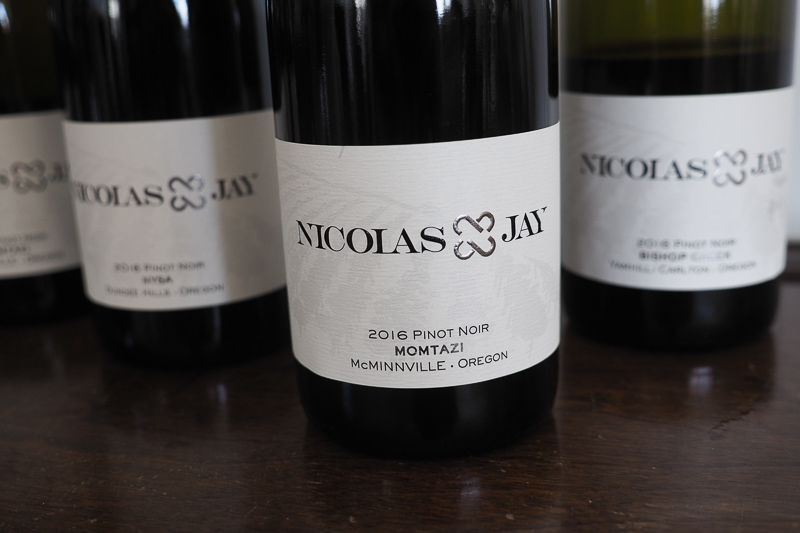
Nicolas Jay Momtazi Vineyard 2016 McMinnville, Oregon
Planted in 1999. Herby slightly rubbery reductive note on the nose. Supple, fresh red cherry and plum fruit, with lovely finesse. Taut and light at the same time, showing restraint and focus. This is sleeping now, but has great promise for the future. Very expressive and mineral on the finish. Intriguing. 94/100
Nicolas Jay Bishop Creek Pinot Noir 2016 Yamhill Carlton, Oregon
Planted in 1988 on marine sedimentary soil. This is concentrated and quite structured with some grunt on the mid-palate. Has broad shoulders and bold tannins. Has weight and power but also lovely finesse. Lots of promise for the future. Such an interesting wine, and really quite serious. 96/100
Find these wines with wine-searcher.com

